Drosera pycnoblasta Diels
The epithet pycnoblasta is from the Greek pycnos (densely packed) and blastos (bud), in reference to the tightly packed stipular bud at the centre of the leafy rosette.
Drosera pycnoblasta is known from Western Australia, with records from Pingelly, Tammin, Goomalling, west of Hatter Hill, and east and south of Lake King.
It grows in clayey, white sand soils over laterite gravels; in white silica sands, sometimes with a little laterite gravel intrusion; and in deep yellow sand soils. All habitats are in low, open heath.
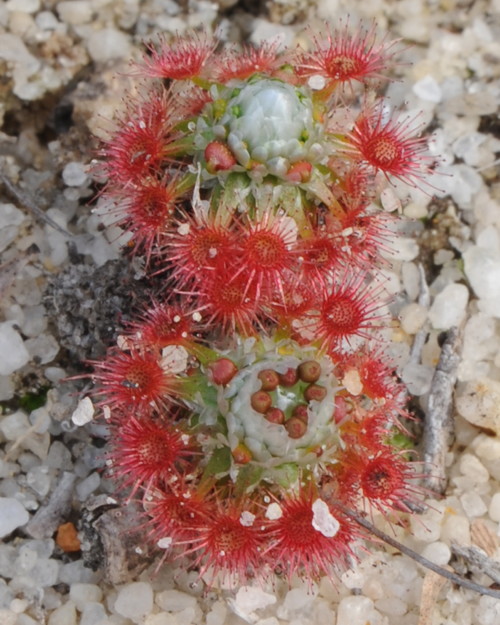
Drosera pycnoblasta. Photo © Richard Nunn.
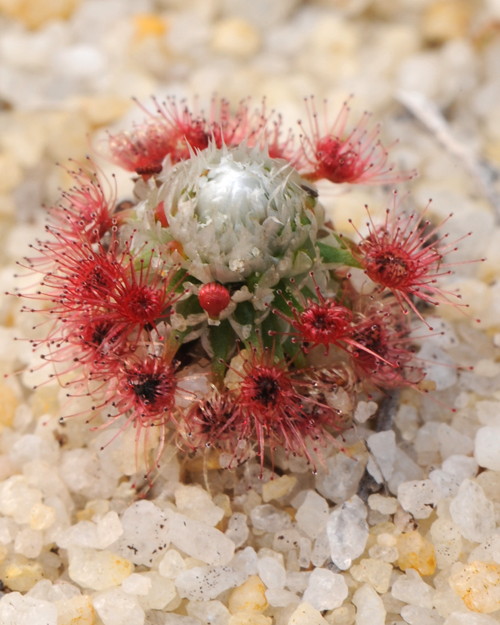
Drosera pycnoblasta. Photo © Richard Nunn.
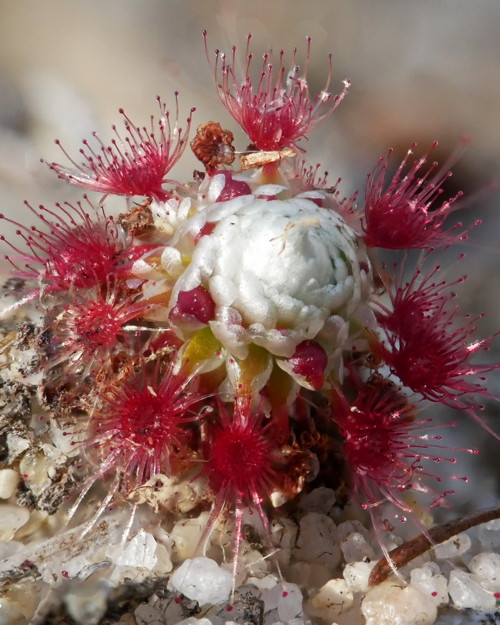
Drosera pycnoblasta. Photo © Thilo Krueger.
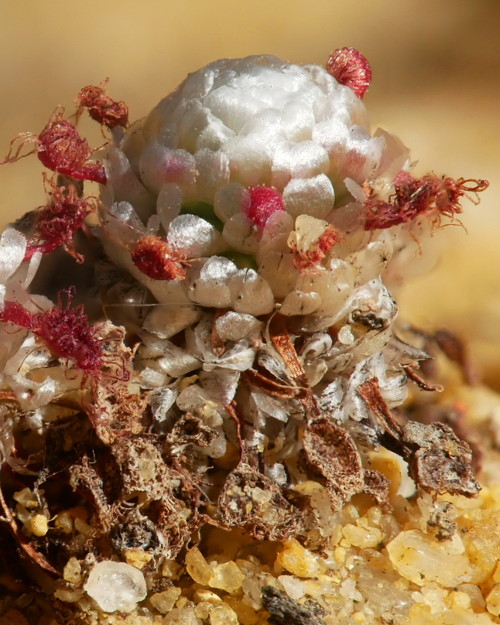
Drosera pycnoblasta. Photo © Thilo Krueger.
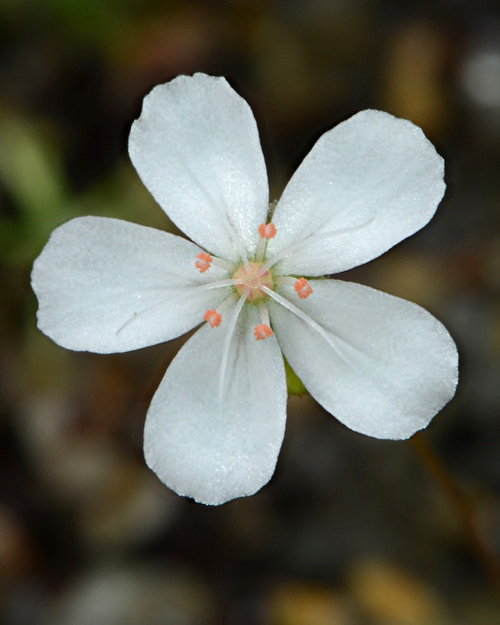
Drosera pycnoblasta. Photo © Richard Nunn.
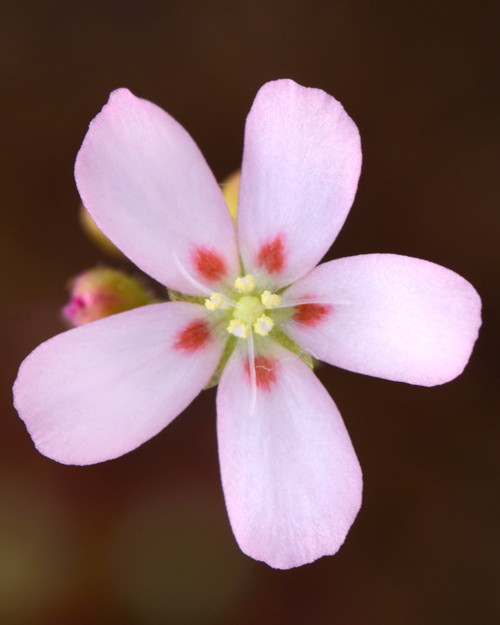
Drosera pycnoblasta. Photo © Richard Nunn.
Drosera pygmaea DC.
The epithet pygmaea is derived from the Latin pygmaeus (dwarf ), in reference to the small form of this species.
Drosera pygmaea is widespread in southeastern Australia, as well as near Albany and Karridale in Western Australia. It is also found in New Zealand (North Island: far north, central volcanic plateau; and South Island: northwestern and southern tips). It is the only pygmy Drosera to be found outside of Western Australia.
It grows a wide range of nutrient poor soils and conditions. On the margins of lakes and swamps it can be submerged for weeks at a time. In alpine areas it can be covered by snow for months and, in heath near Sydney, it occurs on laterite soils that are baked dry for weeks each year. In New Zealand, it can be found in sub-alpine ash deposits on the volcanic plateau and in mossy loam in the South Island.
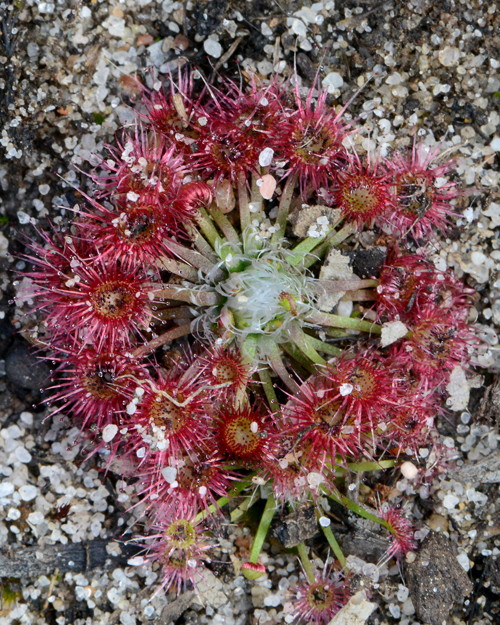
Drosera pygmaea. Photo © Richard Nunn.
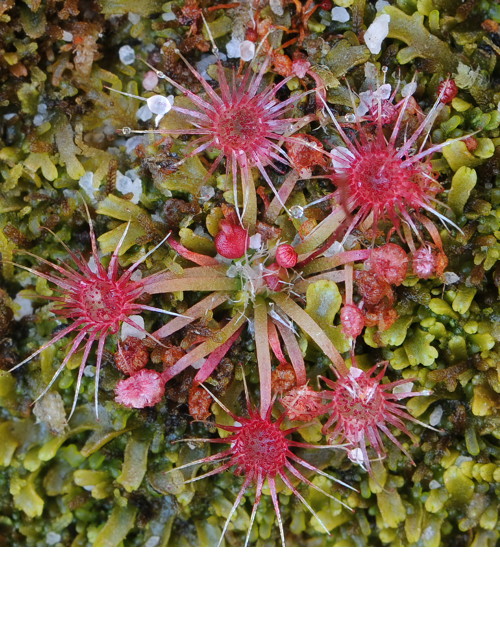
Drosera pygmaea. Photo © Richard Nunn.
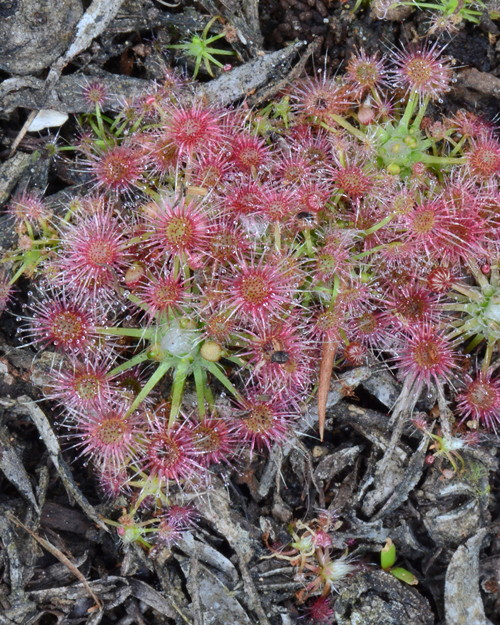
Drosera pygmaea. Photo © Richard Nunn.
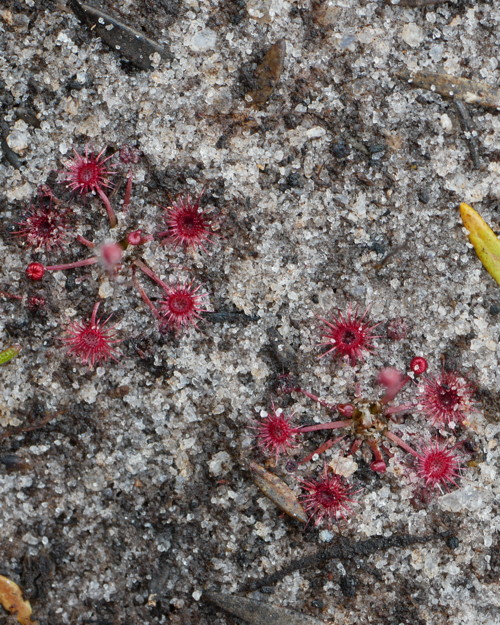
Drosera pygmaea. Photo © Thilo Krueger.
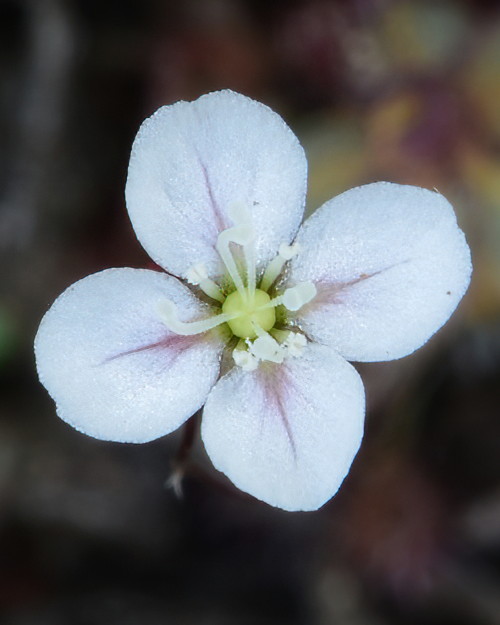
Drosera pygmaea. Photo © Richard Nunn.
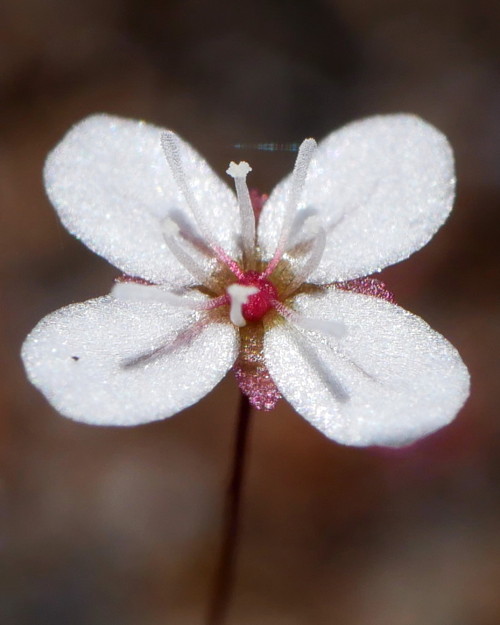
Drosera pygmaea. Photo © Thilo Krueger.
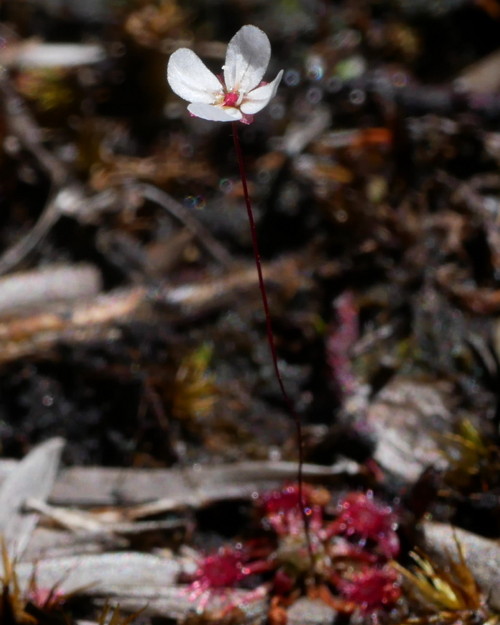
Drosera pygmaea. Photo © Thilo Krueger.
Drosera rechingeri Strid
The epithet rechingeri honours Karl Heinz Rechinger (1906–1998), a collector, taxonomist and flora writer. He was commemorated by Arne Strid, who collected this species with Rechinger on their joint 1982 excursion to the Kalbarri National Park.
Drosera rechingeri is known from Western Australia, with records from Kalbarri, Ajana, Binnu, south of Mingenew and southeast of Dongara.
It grows in deep, pure white silica sand or mixed silica sand, and yellow sand in open heath.
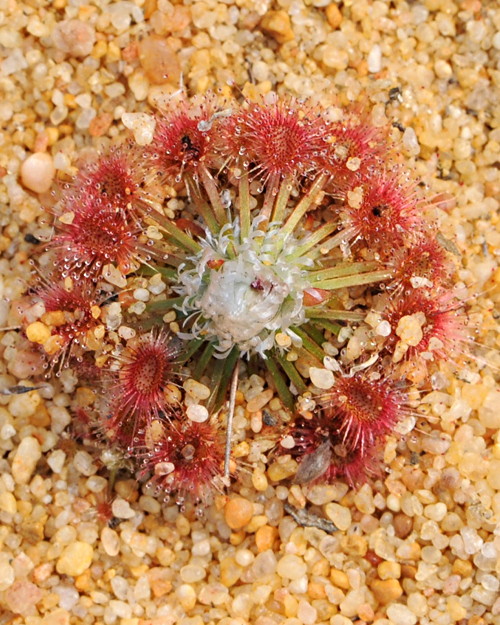
Drosera rechingeri. Photo © Richard Nunn.
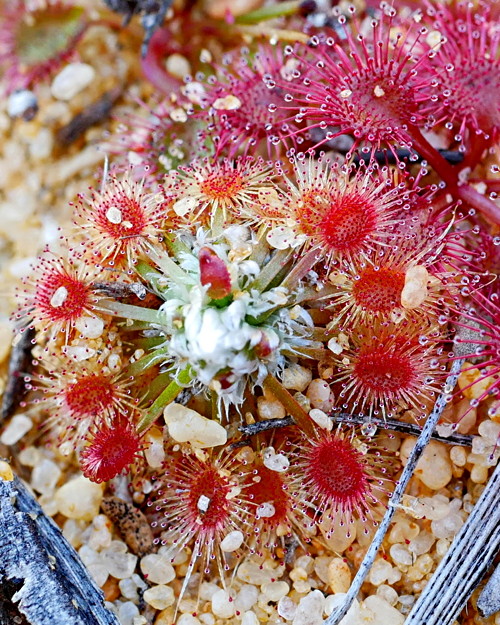
Drosera rechingeri. Photo © Thilo Krueger.
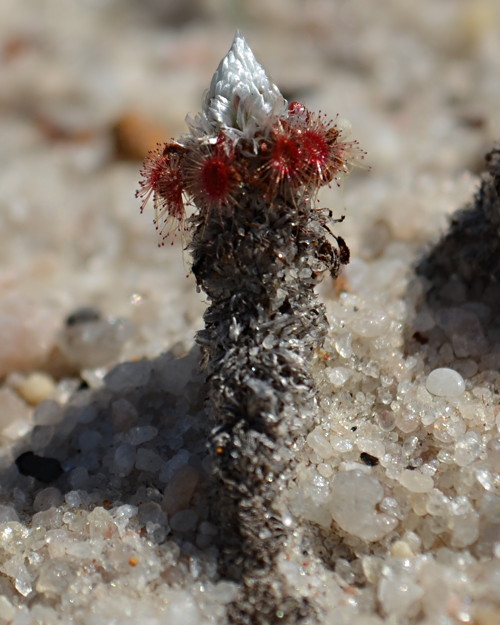
Drosera rechingeri. Photo © Thilo Krueger.
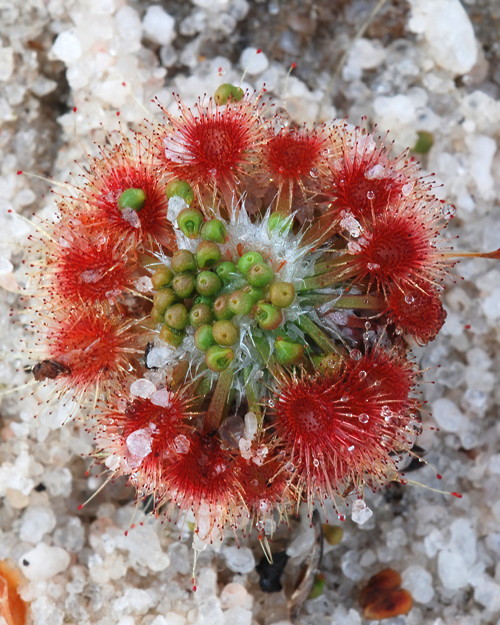
Drosera rechingeri. Photo © Richard Nunn.
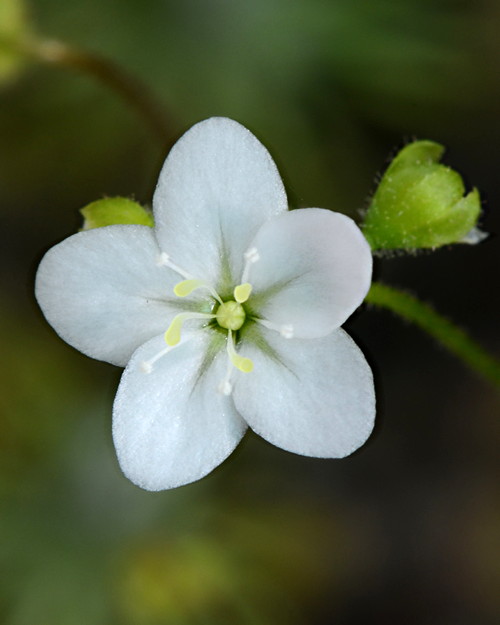
Drosera rechingeri. Photo © Richard Nunn.
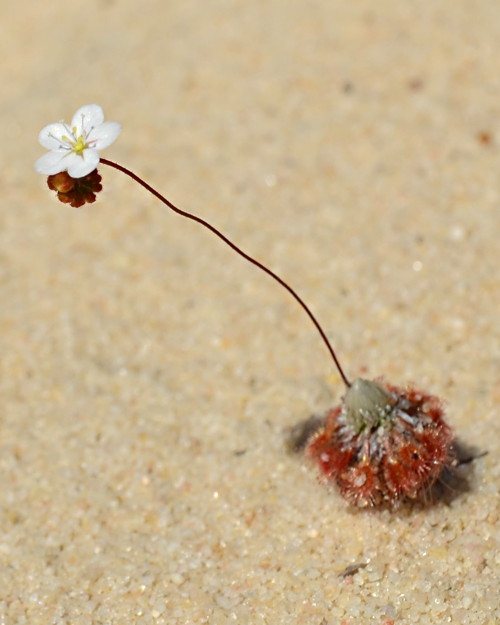
Drosera rechingeri. Photo © Thilo Krueger.
Drosera roseana N.G.Marchant & Lowrie
Drosera roseana is named in honour of Steve Rose (1950–2015), gold prospector, photographer and enthusiast of native carnivorous plants and orchids, who has carried out extensive field studies of pygmy Drosera.
Drosera roseana is known from Western Australia, with records from the south coast from Albany to Augusta.
It grows in peaty sand on the margins of swamps.
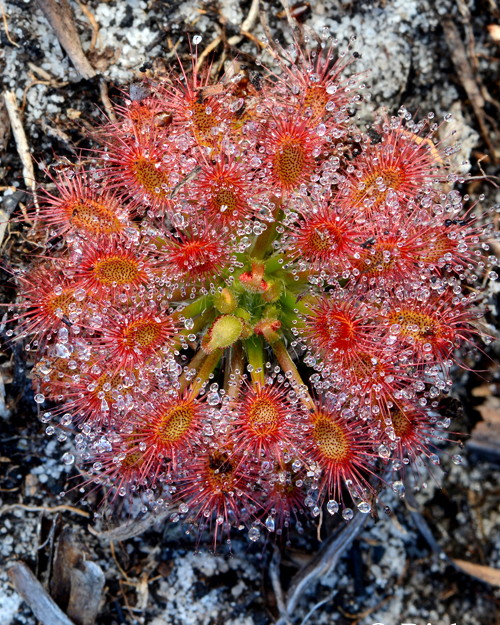
Drosera roseana. Photo © Richard Nunn.
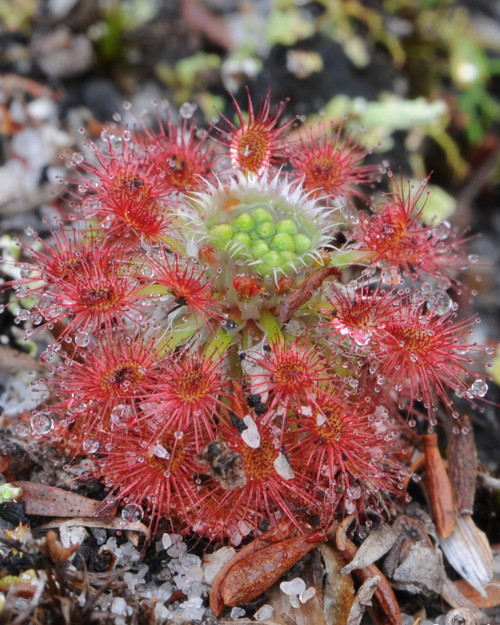
Drosera roseana. Photo © Richard Nunn.

Drosera roseana. Photo © Richard Nunn.
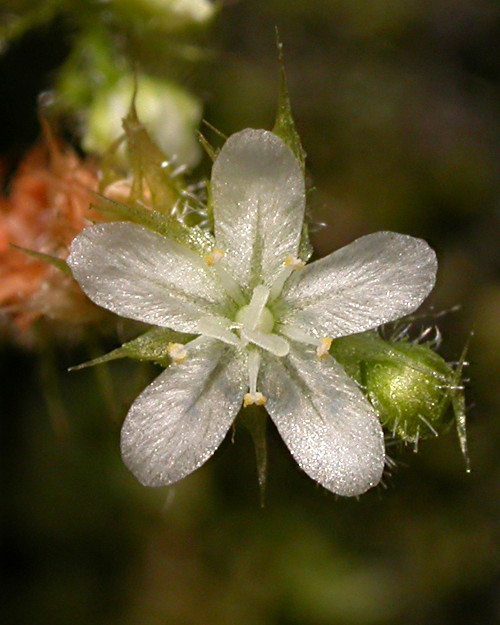
Drosera roseana. Photo by John Brittnacher.
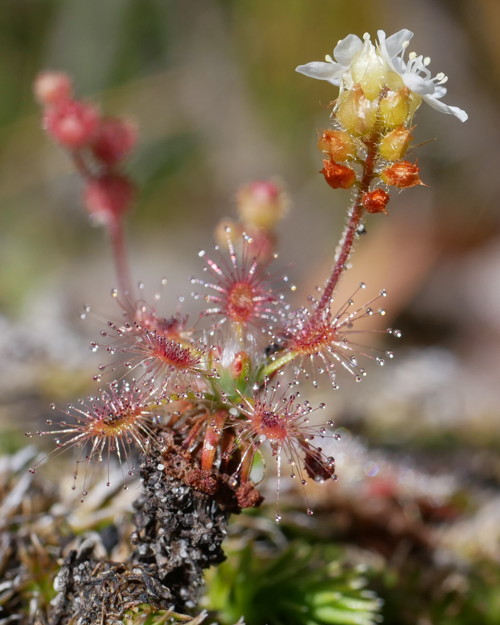
Drosera roseana. Photo © Thilo Krueger.
Drosera sargentii Lowrie & N.G.Marchant
The epithet sargentii honours Oswald Hewlett Sargent (1880–1952), a Pharmacist of York, Western Australia, who made major contributions to Western Australian botany and studies on Drosera.
Drosera sargentii is known from Western Australia, with records from Esperance to Cape Le Grand and Cape Arid.
It grows in deep, white silica sand on low, open heath; or on coastal, consolidated sand dunes.
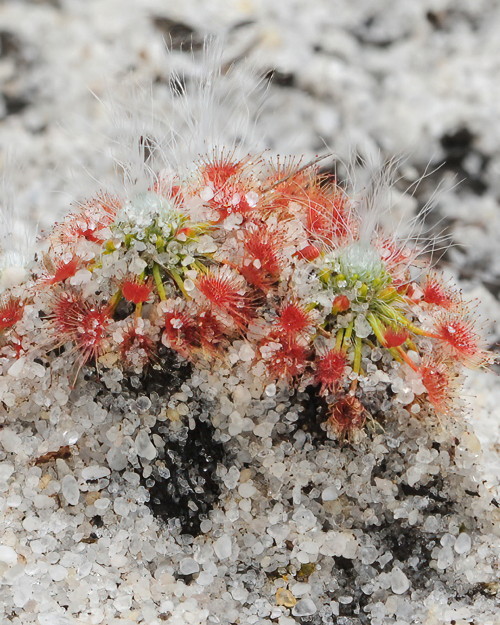
Drosera sargentii. Photo © Richard Nunn.
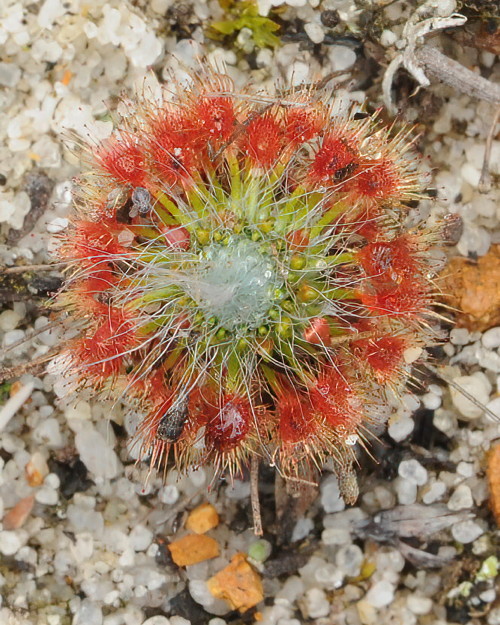
Drosera sargentii. Photo © Richard Nunn.
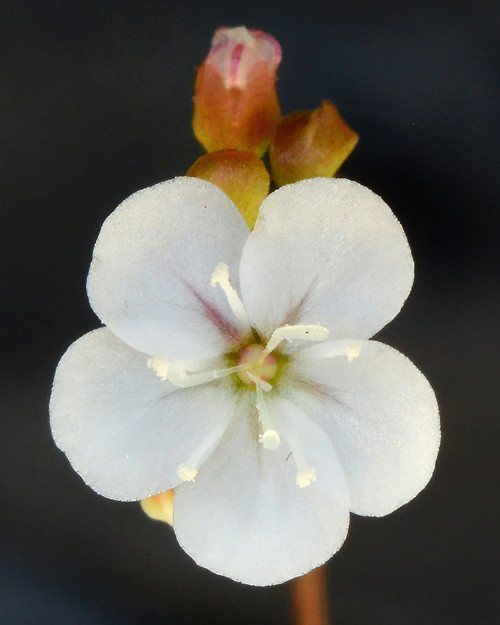
Drosera sargentii. Photo © Richard Nunn.
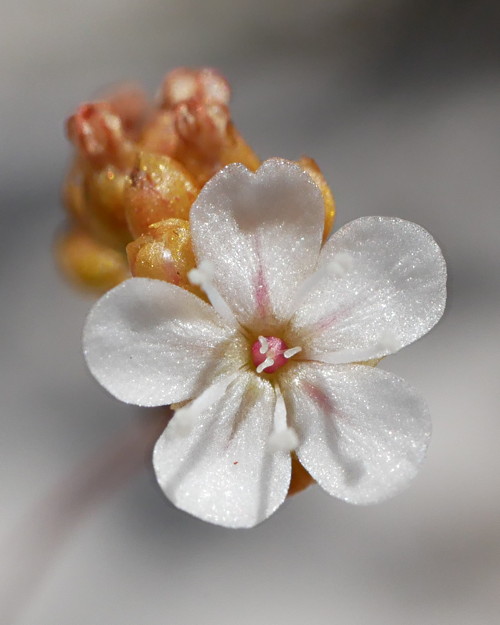
Drosera sargentii. Photo © Thilo Krueger.
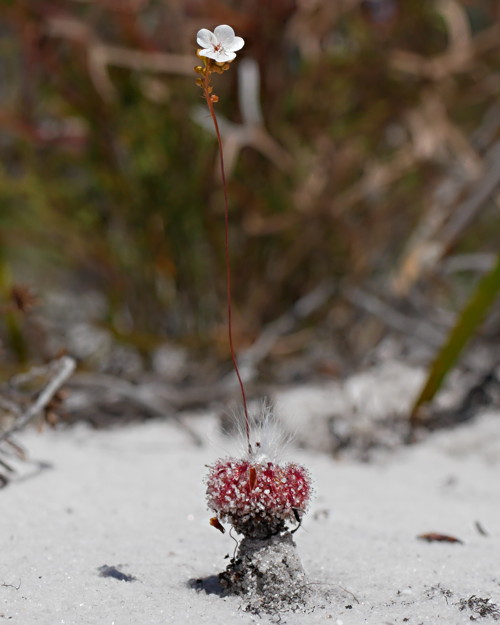
Drosera sargentii. Photo © Thilo Krueger.
Drosera scorpioides Planch.
Drosera scorpioides is named from the Latin scorpio (scorpion) and suffix -oides (like, resembling), probably in reference to the unique laminae of this species, which are usually curved in a manner reminiscent of a poised scorpion’s tail.
Drosera scorpioides is known from Western Australia, with records from Albany, Manypeaks, Bowelling and Gidgegannup.
It grows on rocky, laterite outcrops mixed with a little silica sand in open areas of woodland or heathland.
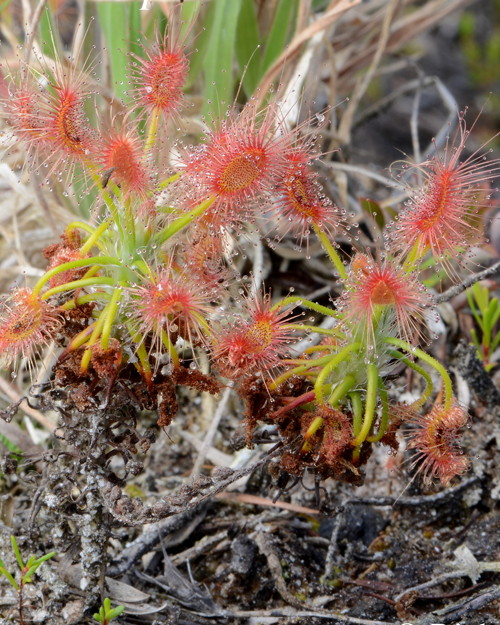
Drosera scorpioides. Photo © Richard Nunn.
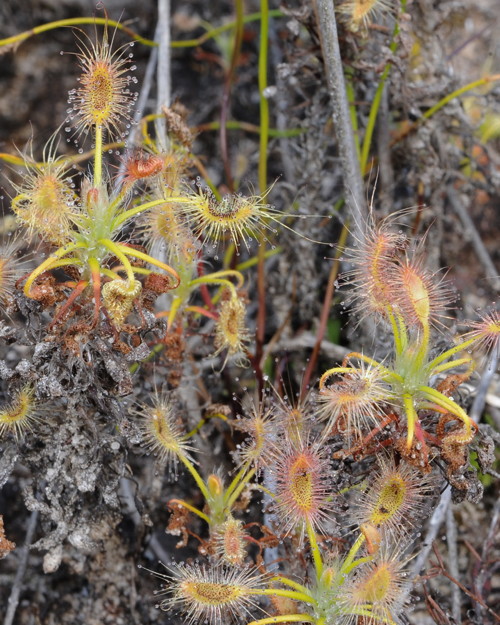
Drosera scorpioides. Photo © Richard Nunn.
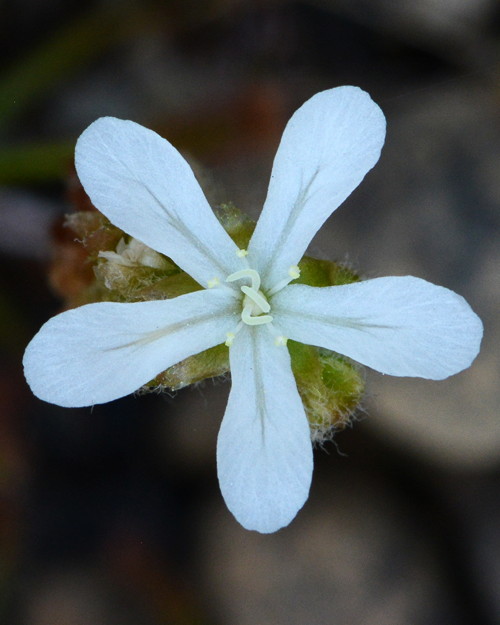
Drosera scorpioides. Photo © Richard Nunn.
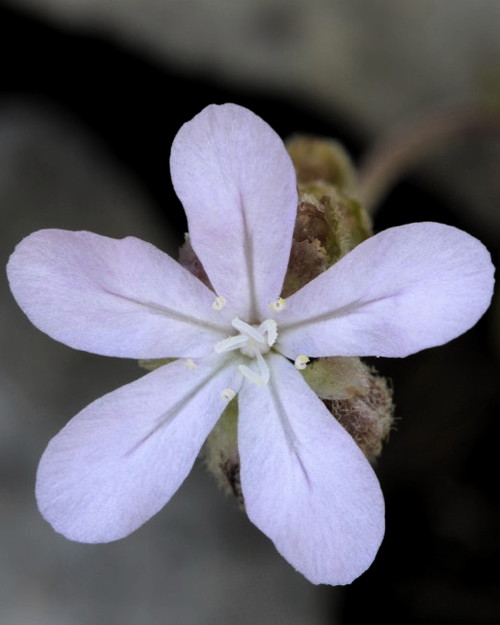
Drosera scorpioides. Photo © Richard Nunn.
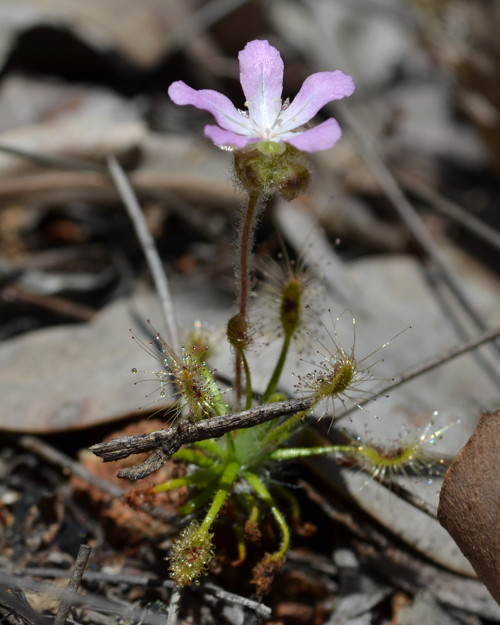
Drosera scorpioides. Photo © Thilo Krueger.
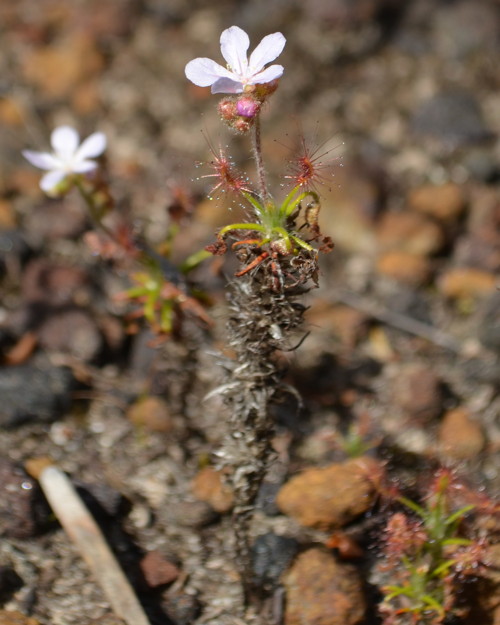
Drosera scorpioides. Photo © Thilo Krueger.
Drosera sewelliae Diels
The epithet sewelliae honours Julia Sewell (1849–1914), who collected botanical specimens near York, Western Australia.
Drosera sewelliae is known from Western Australia, with records from Chittering Valley, Muchea and Toodyay.
It grows in laterite mixed with silica sand soil in bright, open forest and in laterite soils over sheet laterite rock.
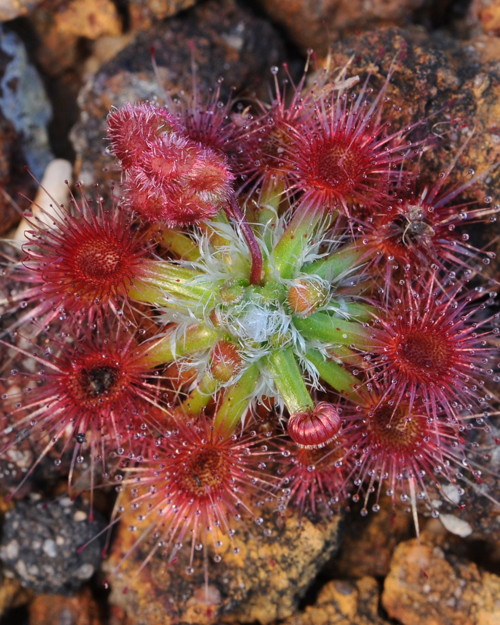
Drosera sewelliae. Photo © Richard Nunn.
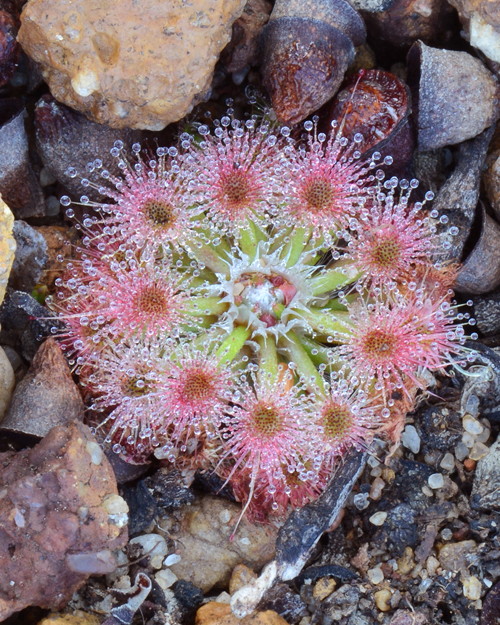
Drosera sewelliae. Photo © Richard Nunn.
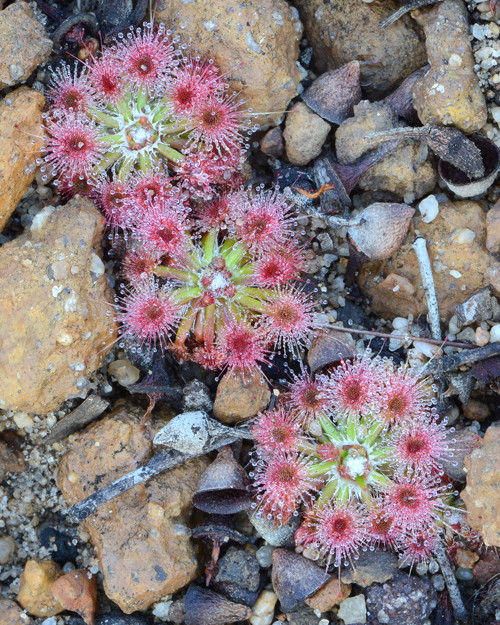
Drosera sewelliae. Photo © Richard Nunn.
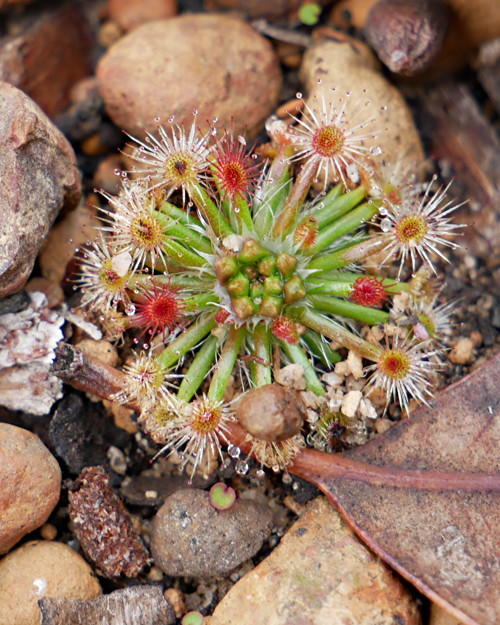
Drosera sewelliae. Photo © Thilo Krueger.
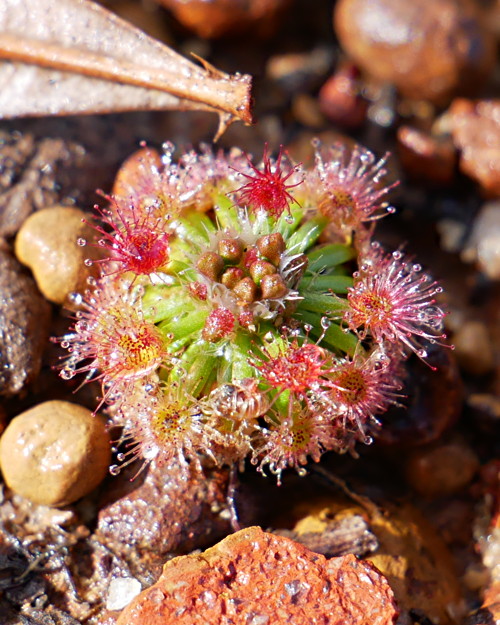
Drosera sewelliae. Photo © Thilo Krueger.
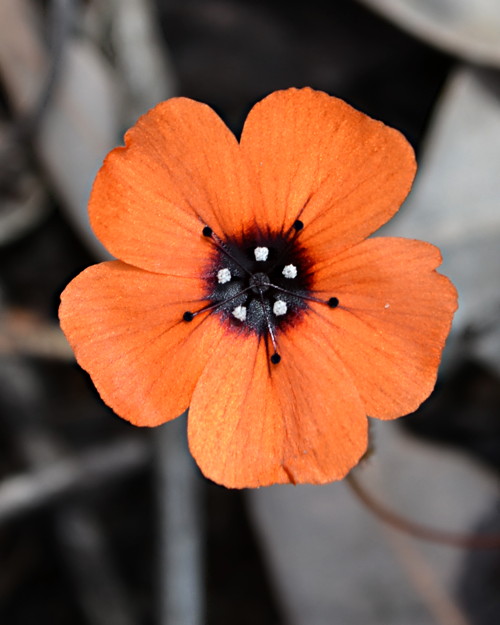
Drosera sewelliae. Photo © Thilo Krueger.
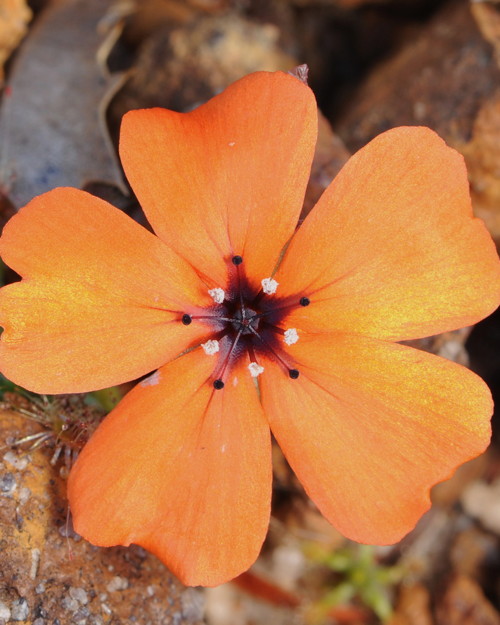
Drosera sewelliae. Photo © Richard Nunn.
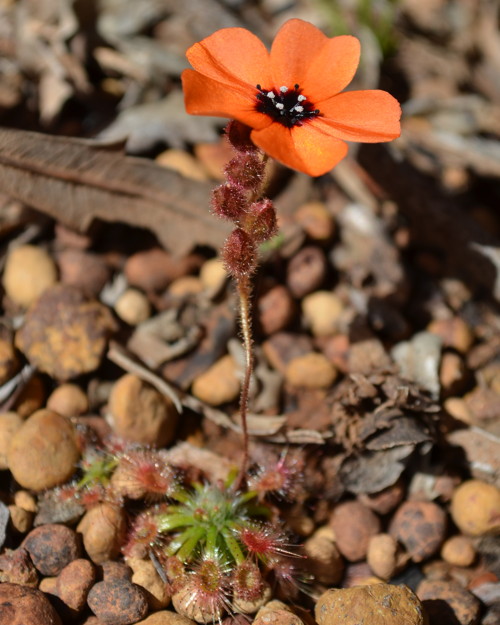
Drosera sewelliae. Photo © Thilo Krueger.
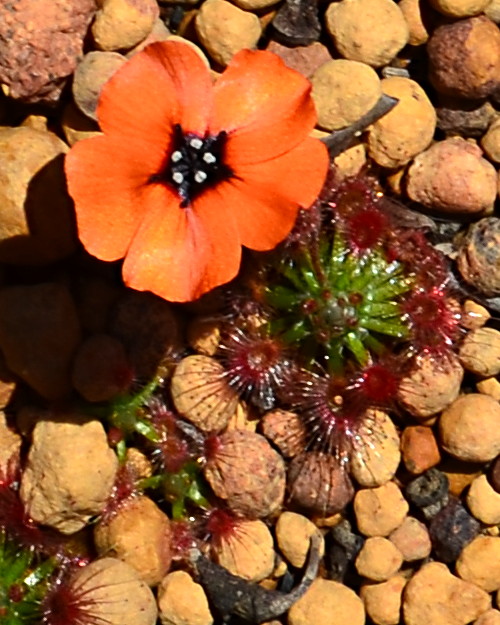
Drosera sewelliae. Photo © Thilo Krueger.
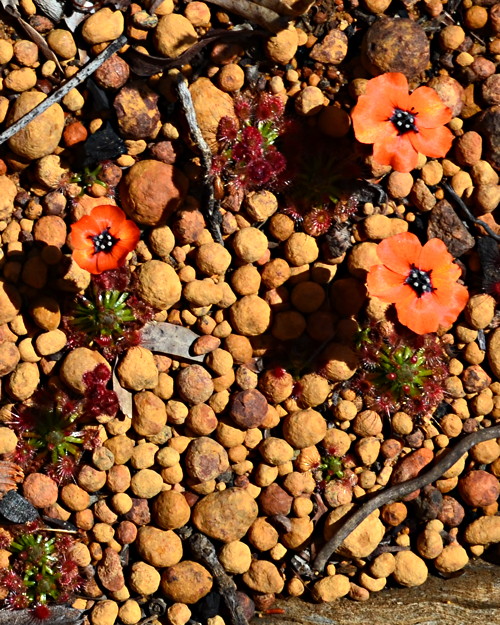
Drosera sewelliae. Photo © Thilo Krueger.
Drosera silvicola Lowrie & Carlquist
Drosera silvicola is named from the Latin silva (woodland), and suffix -cola (dwelling), in reference to the Jarrah woodland habitat where this species occurs.
Drosera silvicola is known from Western Australia, with records from Avon Valley, North Bannister and Boddington.
It grows in laterite soils in open jarrah forest on the summits of very high hills.
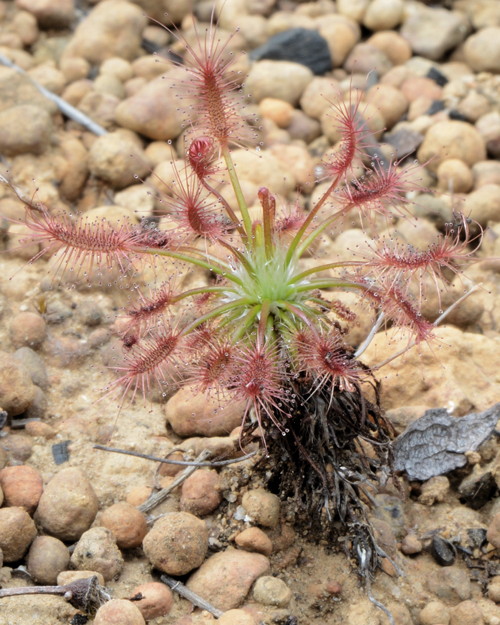
Drosera silvicola. Photo © Richard Nunn.
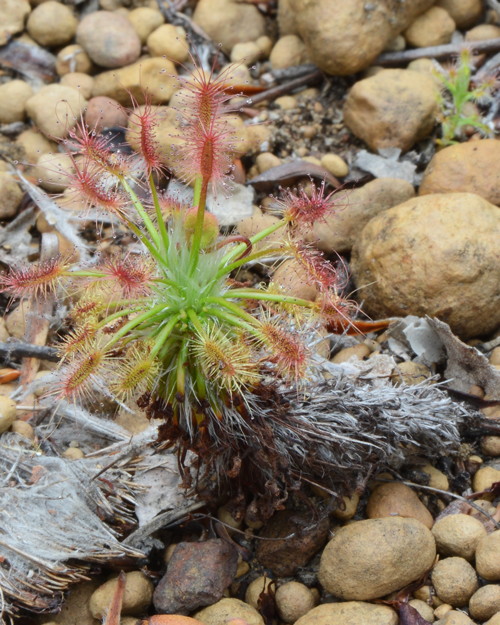
Drosera silvicola. Photo © Richard Nunn.
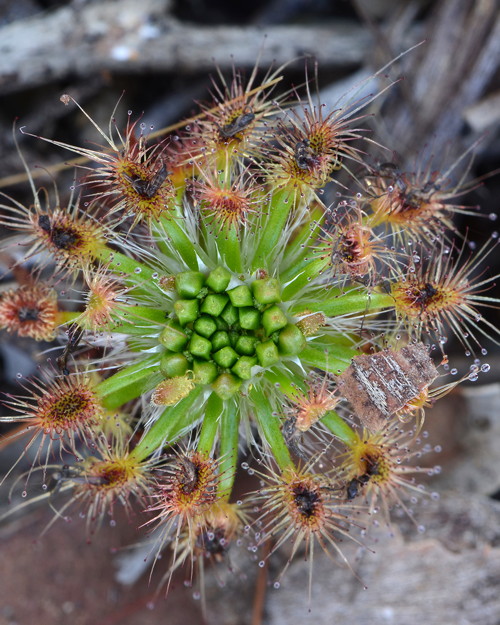
Drosera silvicola. Photo © Richard Nunn.
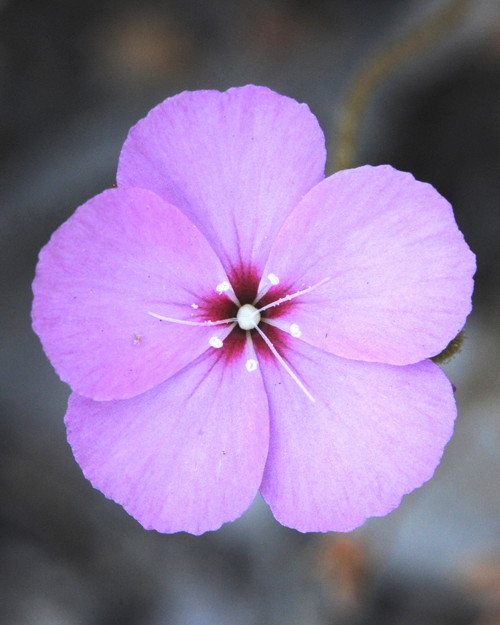
Drosera silvicola. Photo © Richard Nunn.
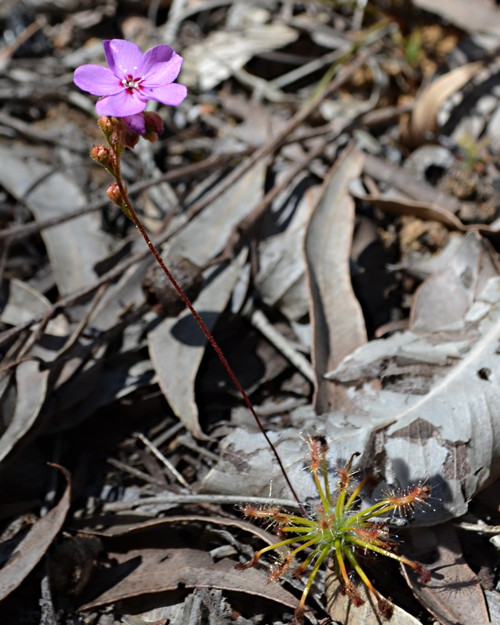
Drosera silvicola. Photo © Thilo Krueger.
Drosera spilos N.G.Marchant & Lowrie
Drosera spilos is named from the Greek spilos (a spot), in reference to the dark pink to reddish blotch always present near the base of the petals.
Drosera spilos is known from Western Australia, with records from Bannister, Bolgart, Cataby, Eneabba, Gillingarra, Muchea, Three Springs, Walkaway and Wyalkatchem.
It grows in loam soils covered with laterite pebbles or in clayey sand often in association with granite outcrops in open areas covered with light heath.
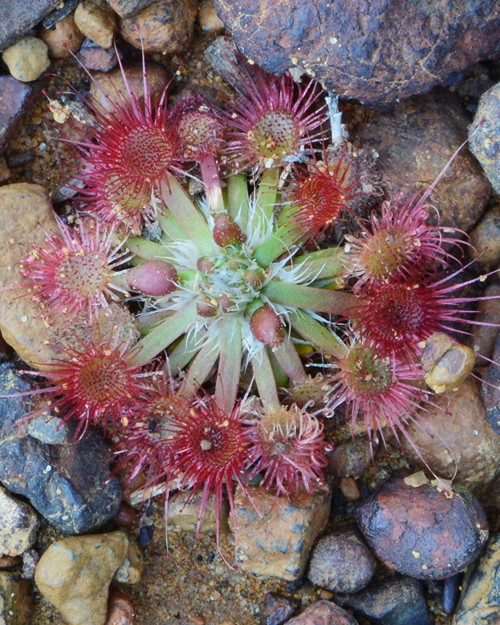
Drosera spilos. Photo © Richard Nunn.
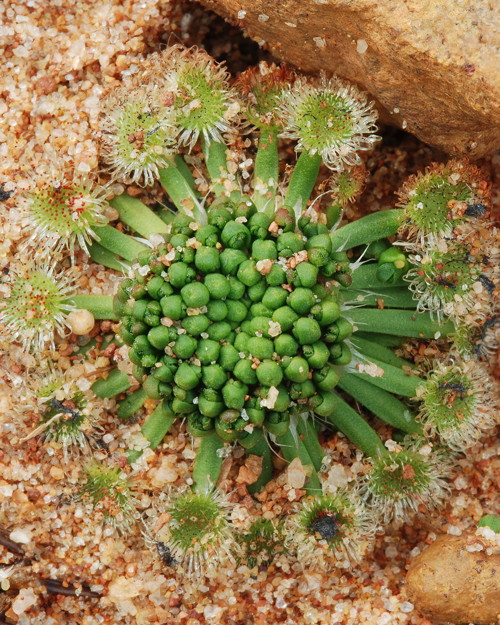
Drosera spilos. Photo © Richard Nunn.
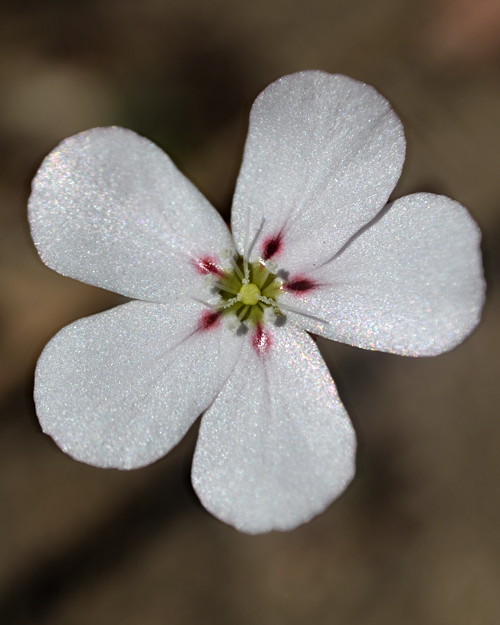
Drosera spilos. Photo © Thilo Krueger.
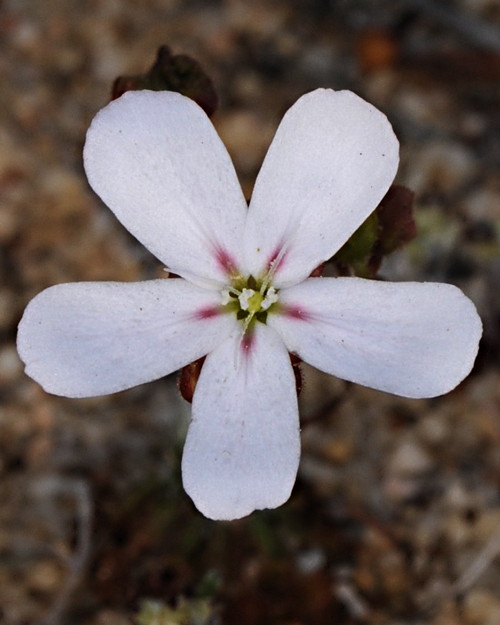
Drosera spilos. Photo © Richard Nunn.
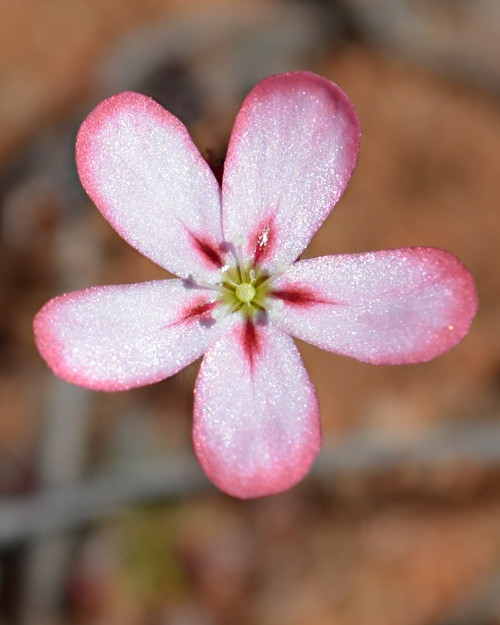
Drosera spilos. Photo © Thilo Krueger.
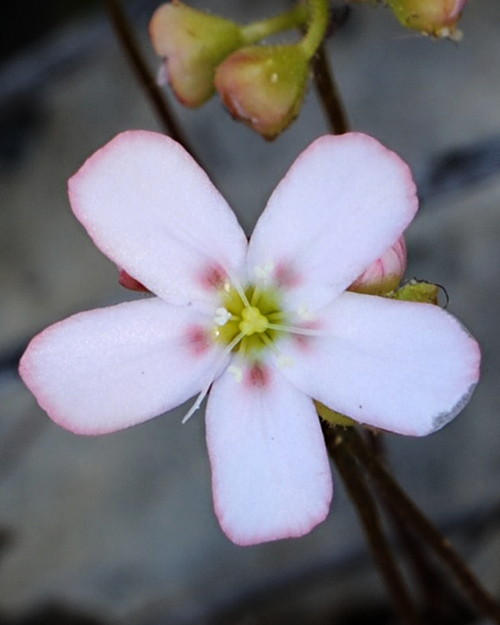
Drosera spilos. Photo © Thilo Krueger.
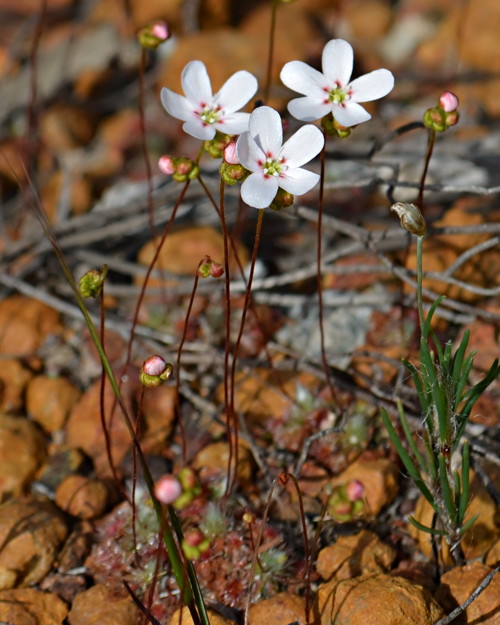
Drosera spilos. Photo © Thilo Krueger.
Drosera stelliflora Lowrie & Carlquist
The epithet stelliflora is derived from the Latin stella (star) and flora (flower), in reference to the star-like shape of the flowers.
Drosera stelliflora occurs in Western Australian jarrah forest between Busselton and Margaret River.
It grows in laterite soils, sometimes mixed with a little silica sand.
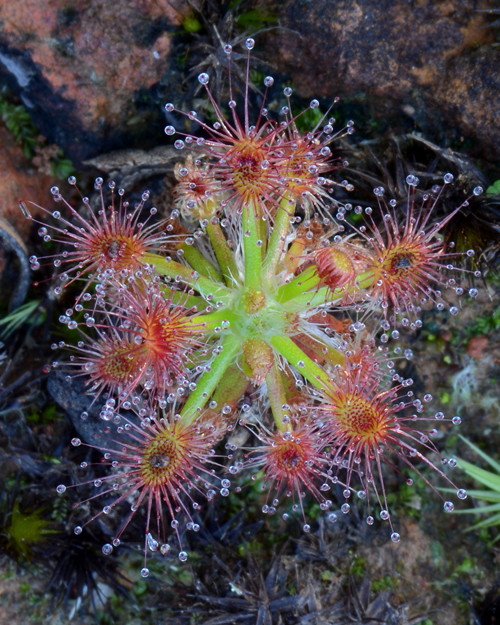
Drosera stelliflora. Photo © Richard Nunn.
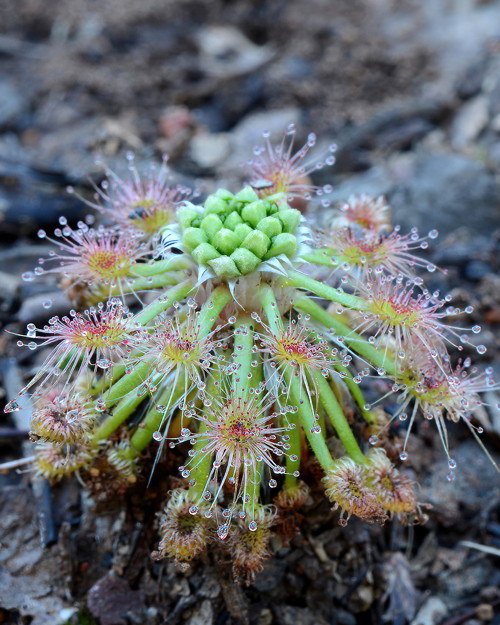
Drosera stelliflora. Photo © Richard Nunn.
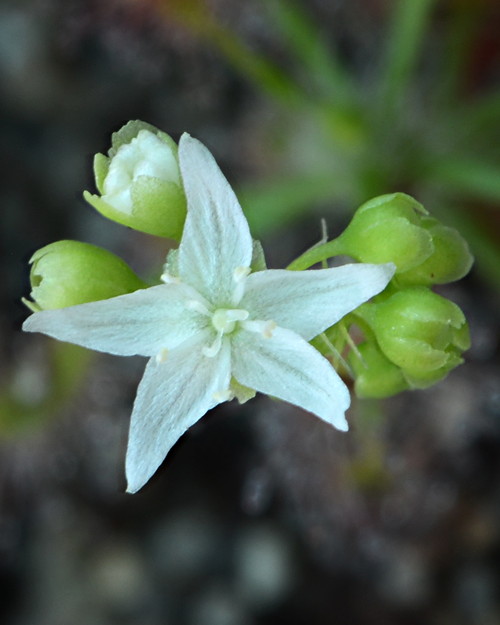
Drosera stelliflora. Photo © Richard Nunn.
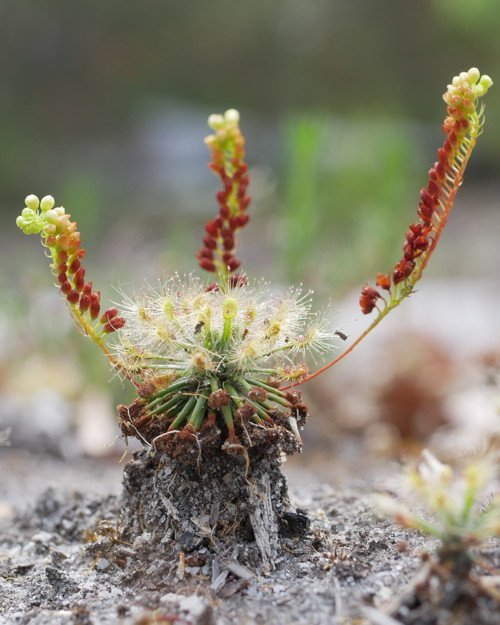
Drosera stelliflora. Photo © Thilo Krueger.
Drosera trichocaulis (Diels) Lowrie
The epithet trichocaulis is derived from the Greek trichos (hair) and caulis (stem) in reference to the long, white, curly, non-glandular wool-like hairs that cover the entire peduncle and rachis of this species.
Drosera trichocaulis is known from Western Australia, with records from the Stirling Range, Ravensthorpe, Hopetoun, Scadden Esperance and Cape Arid.
It grows in deep white sand, or laterite and silica sand soils, under and between low heath and open woodland in a coastal region.
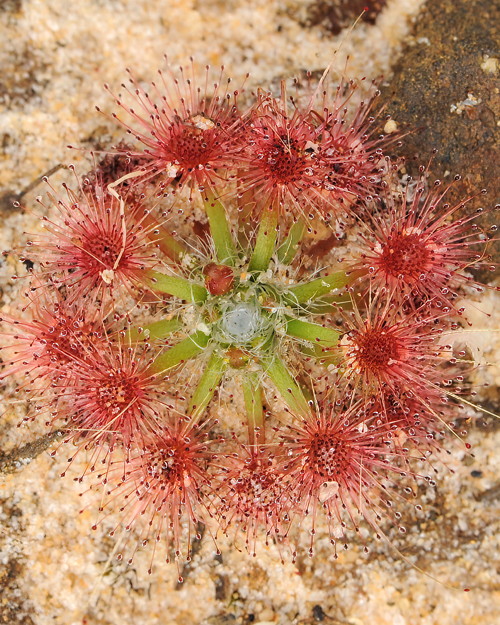
Drosera trichocaulis. Photo © Richard Nunn.
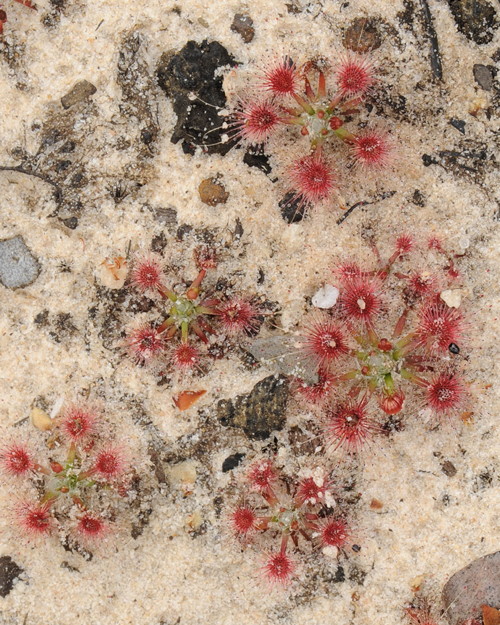
Drosera trichocaulis. Photo © Richard Nunn.
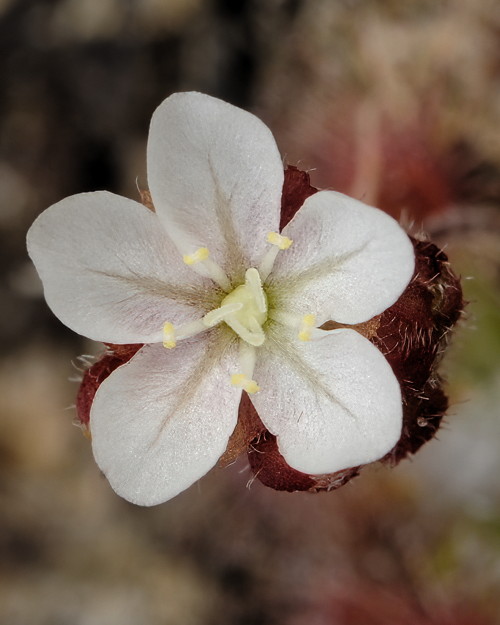
Drosera trichocaulis. Photo © Richard Nunn.
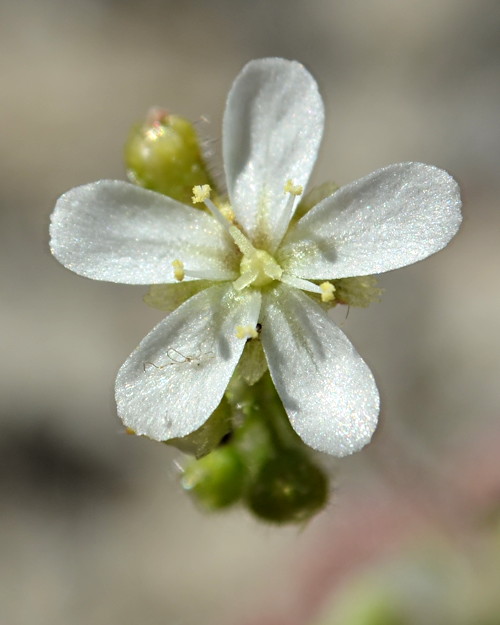
Drosera trichocaulis. Photo © Thilo Krueger.
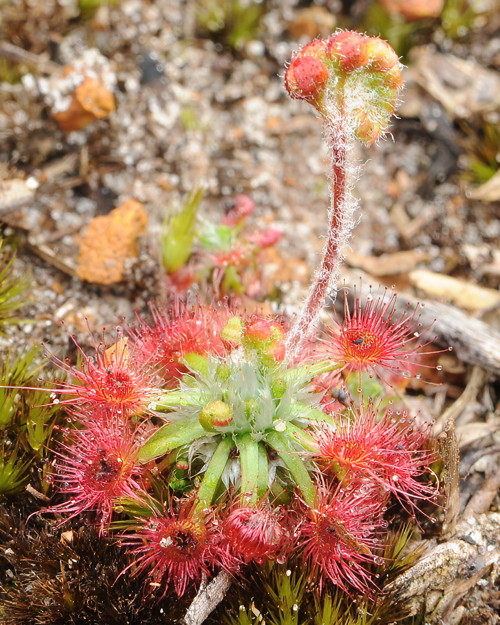
Drosera trichocaulis. Photo © Richard Nunn.
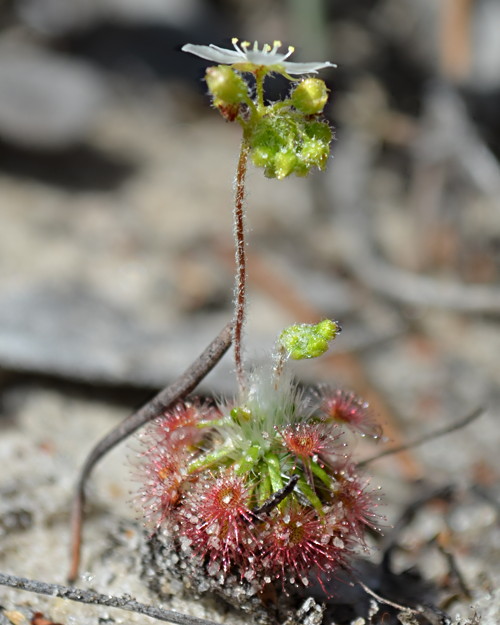
Drosera trichocaulis. Photo © Thilo Krueger.
Drosera verrucata Lowrie & Conran
The epithet verrucata is derived from the Latin verrucatus (wart-like in appearance), in reference to the unique, discus-shaped seed, which bear distinctive, irregular, wart-like-outgrowths around the periphery of an otherwise ± smooth surfaced seed.
Drosera verrucata is known from Western Australia, with records common in the Albany to Manypeaks region.
It grows in clayey sand soils between and under low shrubs on heathland and low scrub land.
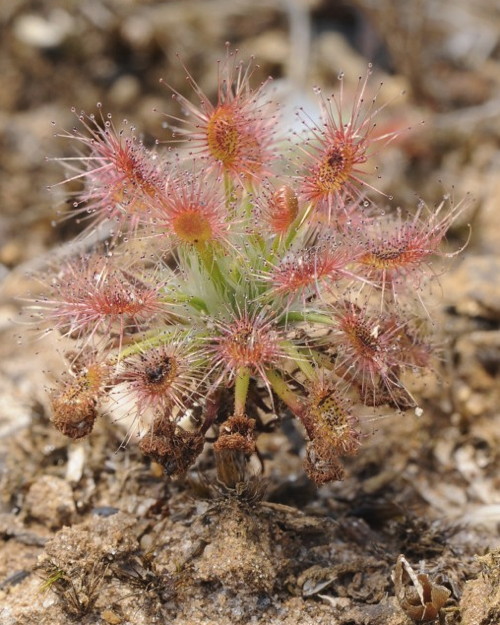
Drosera verrucata. Photo © Richard Nunn.
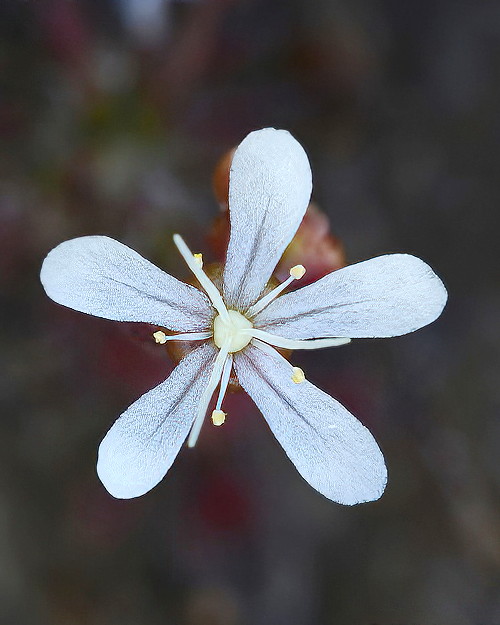
Drosera verrucata. Photo © Richard Nunn.
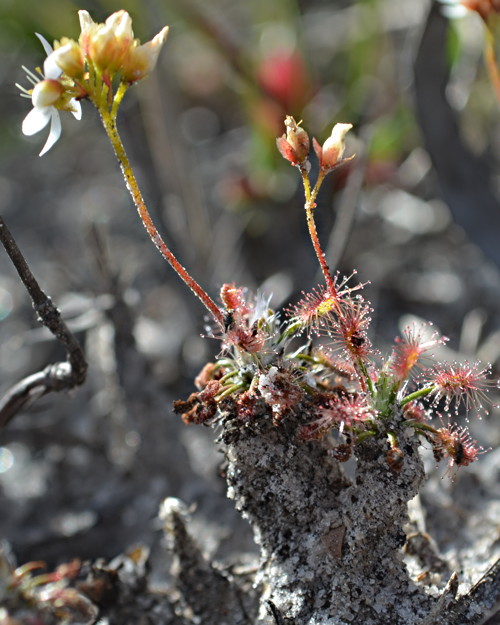
Drosera verrucata. Photo © Thilo Krueger.
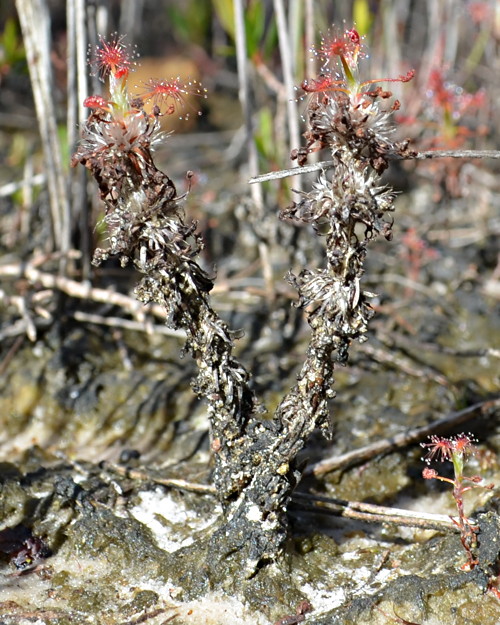
Drosera verrucata. Photo © Thilo Krueger.
Drosera walyunga N.G.Marchant & Lowrie
The epithet walyunga is the Noongar indigenous Australian word walyunga, recognising the occurrence of this species in and near the Walyunga National Park. The meaning of walyunga is unknown.
Drosera walyunga is known from Western Australia, with records from Walyunga National Park and near surrounding regions.
It grows in sandy white clay with a thin overlay of laterite pea gravel, on and around winter-wet springs, seepage areas and sand swales. It is frequently seen in association with granite outcrops in open areas covered with light heath
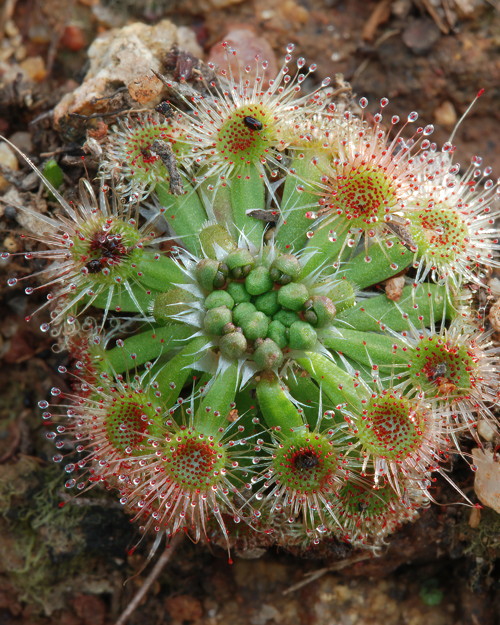
Drosera walyunga. Photo © Richard Nunn.
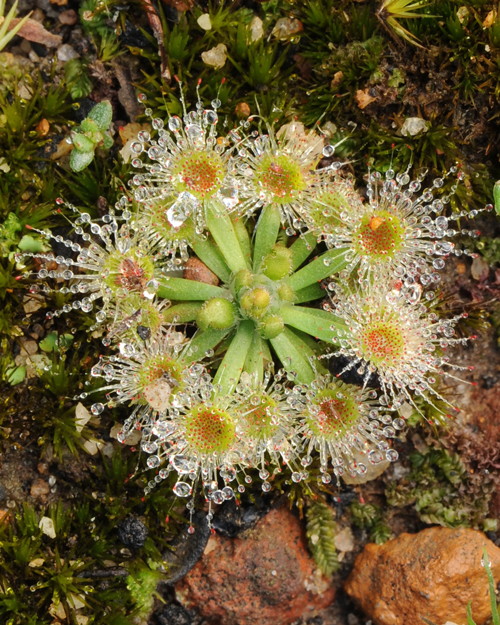
Drosera walyunga. Photo © Richard Nunn.
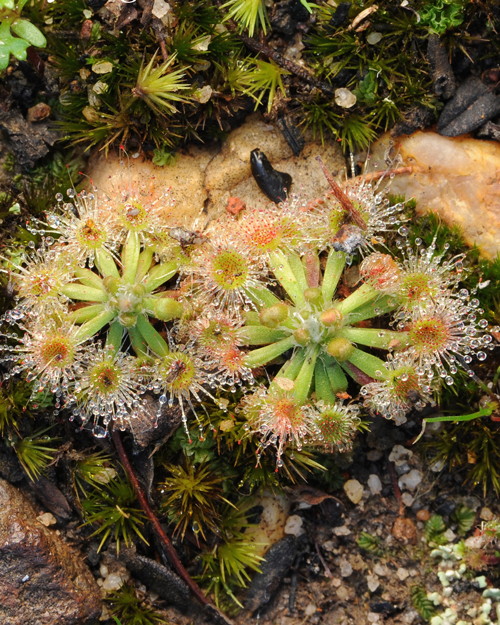
Drosera walyunga. Photo © Richard Nunn.
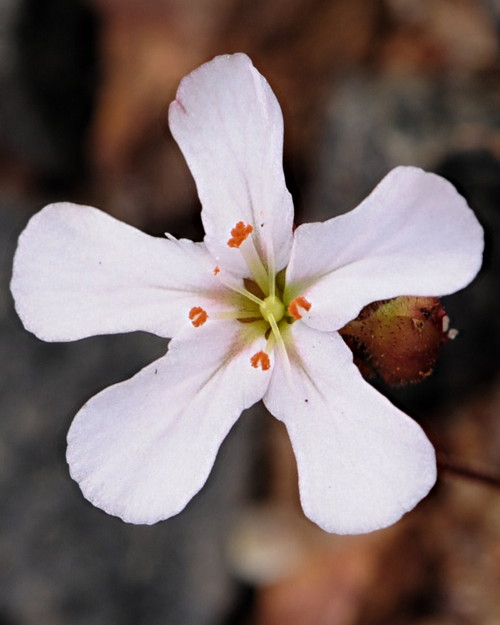
Drosera walyunga. Photo © Richard Nunn.
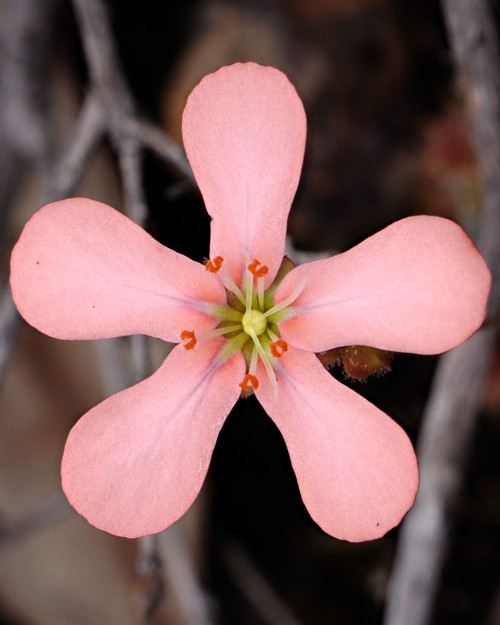
Drosera walyunga. Photo © Richard Nunn.
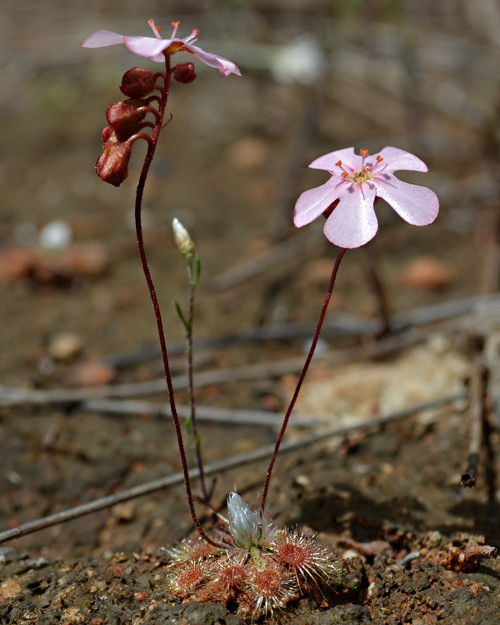
Drosera walyunga. Photo © Thilo Krueger.
